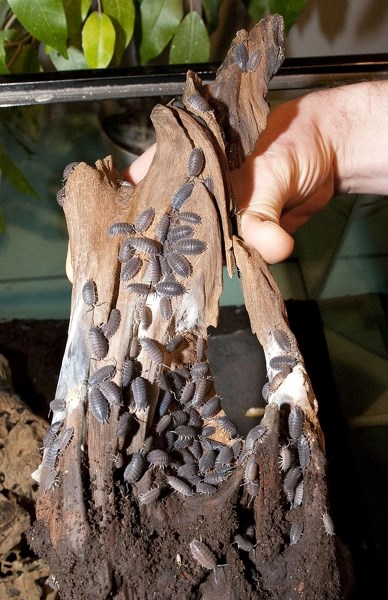I like bugs, but the sight of them in my house always makes me murderous.
Sowbugs are the worst. I’d find these black, pinky-nail sized critters skittering behind my bedroom curtain every week in my old home, and my first instinct was always to squish ’em. No matter how well I sealed the cracks in my windows, they always seemed to get in, driving me to distraction.
It was with mixed emotions, then, that I recently watched entomologist Peter Heule pick up a chunk of wood covered with hundreds of them in the Royal Alberta Museum’s bug room.
Sowbugs are actually crustaceans, he explained, and have a lobster-like carapace with seven sets of wriggling white legs.
“Ordinarily, they’re not a problem,” he said, but they can signal trouble if they’re in your house. “If any piece of wood approximates this in your house, it’s time to do some renovations.”
Bugs are actually active year-round even if we don’t see them, Heule said. If you could sneak into a vole’s tunnels under the snow, you’d see spiders and other critters crawling about all winter.
A recent survey by Alberta entomologists found some 206 species of bugs that were active during the winter, about 30 of which were indoors, said John “the Nature Nut” Acorn, a professor of renewable resources at the University of Alberta.
Great. So why are they in my house?
A lot of these bugs are looking for shelter, Acorn explained. Outdoors, that means under a log or tree bark. Since nobody’s house is perfectly sealed, many wander indoors in search of lodging.
“The problem with houses for most bugs is that they’re too warm and they’re too dry,” Acorn continued. Most will be dead by the end of fall. Others will hide in the walls, come out too early and perish on your windowsill.
But some thrive, noted Robin Leech, an Edmonton-based arachnologist. Larder beetles (little black oblong bugs with a yellow band) flourished when settlers replaced native plants with yummy grains, for example. Humans have also helped the European house spider spread everywhere. Leech has even seen them in Antarctica.
And even the best of homes will have a few bugs in the woodwork, he added.
“You may try to clean these guys up, but eventually you’re going to get them,” he said.
Of the many bugs that you’re likely to see, the two-spot ladybug is probably one of the more tolerable guests in a winter home. These guys are fairly small, Acorn said, and can actually have up to 10 spots on their shells.
“They appear to mark their overwintering site with a chemical marker,” he noted, so any home with ladybugs now can expect to get them again next winter.
Two-spots will usually sit around your house all winter, only to wake up in the spring and bonk against your windows.
“The question I get most often is, ‘How do I help it?’ ” Acorn said.
He advised putting these bugs in a cool, dark place and possibly feeding them banana.
Leaky cabins tend to host a lot of many-plumed moths this time of year, Acorn said.
“They’re not clothes moths,” he noted, and they won’t eat your sweaters. Clothes moths store their wings parallel to their body at rest, he explained, while the many-plumed ones hold them flat against whatever surface they rest upon. Their wings resemble six separate feathers, hence “many-plumed.”
Spiders are a common house guest and a benefit for most homes, Leech said, since they eat all the other bugs.
“You essentially have a choice. You can have one spider you see every once in a while, or a whole bunch of different things you may see frequently.”
Most basements will be home to a European house spider which, with its legs outstretched, is the size of a loonie, Leech said.
“It’s probably the only spider most people are going to be seeing,” he said.
These spiders usually camp in corners inside a funnel-shaped web, Leech said, but can also roam about like a wolf spider, pouncing on passing sowbugs. If they’re in their web, you can send them charging out if you tap on it.
Spiders have hairy legs that they use to sense changes in air pressure Leech said, such as that of a descending broom. Spiders run away from the broom’s high pressure front, which often sends them “charging” at the person wielding it.
Sowbugs are drawn by moisture and rotting wood, Heule said, as they breathe through gills. They’re great in a compost pile, since they’re decomposers, but can be a sign of leaks or rot indoors.
“The sowbugs might just be a symptom of the problem,” he said.
Very few winter bugs will harm you or your home, Heule said. The only ones that are worth breaking out the poison for are cockroaches and bedbugs.
If you want to reduce the number of bugs in your home, seal it up, he continued. Caulk around your faucets and dryer vents, fill cracks in your foundation and put weather stripping around your windows and doors.
“Any good exterminator should seal your house before they apply pesticides,” he said. These steps will also save you energy on your heating bills, he added.
If you see a bug in your home, you can usually ignore it, Acorn said.
“Use it as an opportunity to get to know some of the other living things hanging out in our part of the world,” he said.
What's that bug?
The City of Edmonton's pest management department can help you identify bugs in your home and offer advice on what to do about them. They can be reached at [email protected].




